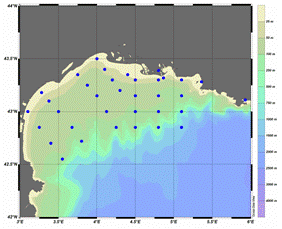COMOR-CARBORHONE 2
| Type | Oceanographic cruise |
|---|---|
| Ship | Téthys II |
| Ship owner | CNRS until 2019 - IFREMER since 2020 |
| Dates | 28/11/2011 - 06/12/2011 |
| Chief scientist(s) | CARIOU Thierry , BOZEC Yann |
STATION BIOLOGIQUE DE ROSCOFF (SBR), SORBONNE UNIVERSITÉ ET CNRS Place Georges Teissier 29680 ROSCOFF +33(0)2 98.29.23.23 |
|
| DOI | 10.17600/11450150 |
| Objective | The main objective of the CARBOHONE 2 cruise was to study air-sea CO2 exchanges in the Gulf of Lion and the Rhone delta. Biogeochemical characteristics of surface waters are influenced by river inflows from the Rhone. Therefore, there were several main technical objectives: -acquiring the maximum amount of data on surface temperature and salinity by using RV L'Europe's TSG to map the Rhone river plume; -acquiring the maximum amount of data on pCO2 and dissolved O2 at the surface to calculate air-sea exchanges in the estuary and on the shelf; - covering a network of 21 stations on the shelf with CTD profiles and sampling a series of biogeochemical parameters in order to determine the processes which control these exchanges of CO2 between the air and sea. These studies will make it possible to determine how the estuarine plume influences air-sea fluxes of CO2 over the entire shelf, which factors control inter-seasonal variations of these CO2 fluxes and how variable the CO2 air-sea fluxes are in the range of estuarine plumes encountered on the global scale of the ocean. During the cruise, the aim was to cover a previously established grid of 31 stations in the Gulf of Lion and to perform a surface leg in the Rhone delta. Between stations, temperature, salinity and pCO2 data were continuously acquired in Gulf surface water. The preliminary results show a very limited estuarine plume. The surface waters of the plume and of the entire Gulf of Lion are mainly under-saturated or balanced in CO2 compared to the atmosphere. |

